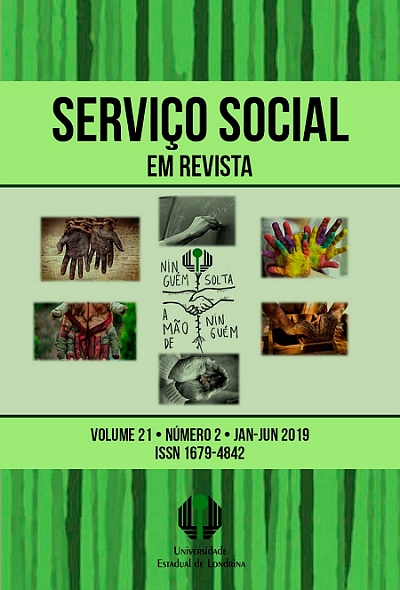Feminicide: the gender of who kills and who dies
DOI:
https://doi.org/10.5433/1679-4842.2019v21n2p333Keywords:
Feminicide. Gender. Violence. ?Abstract
This research, based on the perspective of feminist theorists and Criminal Law, Criminology, Anthropology and Juridical Sociology works, analyzes the close relationship between domestic violence and feminicides perpetrated in the marital and/or intimacy sphere. It aims to demonstrate the existence of an intrinsic relationship between the gender of who kills and who dies by exposing how power relations are capable of boosting and legitimizing ownership and control over the female body, placing feminicide beyond its symbolic load as an inaugural step to recognize the problematic, coferring it the status of reference for the creation of public policies to face gender violence, without neglecting considerations about punitivist desires and the consequent demand for judicialization of the feminist guidelines in the national scenario, highlighting how the Feminicide Law has contributed to this debate resumption.Downloads
References
ANDRADE, Vera Regina Pereira. Sistema penal máximo x cidadania mínima: códigos da violência na era da globalização. 2. ed. Porto Alegre: Editora Livraria do Advogado, 2016.
AZEVEDO, Elisa Girotti; CELMER, Rodrigo Ghringhelli. A violência de gênero, produção legislativa e discurso punitivo: uma análise da Lei nº 11.340/2006. Boletim do IBCCRIM, São Paulo, ano 14, n. 170, p. 15-17, jan. 2007.
BRASIL. Lei 11.340 de 7 de agosto de 2006. Cria mecanismos para coibir a violência doméstica e familiar contra a mulher. Brasília: Presidência da República, 2006.Disponível em: <http://www.planalto.gov.br/ccivil_03/_Ato2004-2006/2006/Lei/L11340.htm>. Acesso em: 7 fev. 2018.
BRASIL. Lei. 13.104 de 9 de março de 2015. Prevê o feminicídio como circunstância qualificadora do delito de homicídio. Brasília: Presidência da República, 2015. Disponível em: http://www.planalto.gov.br/ccivil_03/_Ato2015-2018/2015/lei/L13104.htm. Acesso em: 7 de fev. 2018.
CAPUTI, Jane; RUSSEL, Diana. Femicide: sexist terrorism against woman. In: RADFORD, Jill; RUSSEL, Diana. Femicide: the politics of woman killing. New York: Twayne Publishers, 1992.
FAUSTO-STERLING, Anne. Dualismos em duelo. Cadernos Pagu, Campinas, n. 17-18, p. 9 - 79, 2001-2002.
FERNANDES, Valéria Diez Scarance. Raio x do feminicídio em São Paulo: é possível evitar a morte. São Paulo: Núcleo de Gênero do Ministério Público de São Paulo, 2018.
JESUS, Jaqueline Gomes de. Orientações sobre identidade de gênero: conceitos e termos. 2. ed. Brasília: Autor, 2012.
MACHADO, Isadora Vier. Para além da judicialização: uma leitura da Lei Maria da Penha (Lei 11.340/06) em três dimensões. In: CARVALHO, Érika Mendes (org.). Direitos fundamentais e sistemas de justiça. Rio de Janeiro: Lumen Juris, 2014. p. 231-255.
PASINATO, Wânia. "Feminicídios" e as mortes de mulheres no Brasil. Cadernos Pagu, Campinas, n. 37, p. 219-246, jul./dez. 2011.
PATEMAN, Carole. O contrato sexual. Rio de Janeiro: Paz e Terra, 1993.
QUINTANA, Carmen Rosa Villa. Modelo de protocolo latino-americano para investigação de mortes violentas de mulheres (femicídios/feminicídios). 2014. Disponível em: http://www.onumulheres.org.br/wp-content/uploads/2015/05/protocolo_feminicidio_publicacao.pdf. Acesso em: 7 jan. 2018.
RADFORD, Jill; RUSSELL, Diana. Femicide: the politics of woman killing. New York: Twayne Publishers, 1992.
RIFIOTIS, Theophilos. Judicialização das relações sociais e estratégias de reconhecimento: repensando a "violência conjugal" e a "violência intrafamiliar". Revista Katálysis, Florianópolis, v. 11, n. 2, p. 225-236. Jul./dez. 2008. DOI https://doi.org/10.1590/S1414-49802008000200008. Disponível em: <http://www.scielo.br/scielo.php?script=sci_arttext&pid=S1414-49802008000200008&lng=pt&tlng=pt>. Acesso em: 30 jan. 2018.
SANTOS, Cecília MacDowell. Da delegacia da mulher à Lei Maria da Penha: absorção/tradução de demandas feministas pelo Estado. Revista Crítica de Ciências Sociais, Coimbra, PT, v. 89, p. 153-170. 2010. Disponível em: http://rccs.revues.org/3759. Acesso em: 29 jan. 2018.
SEGATO, Rita Laura. Que és un feminicídio: notas para un debate emergente. Brasília: Universidade de Brasília, 2006. (Série Antropologia, 401).
Downloads
Published
How to Cite
Issue
Section
License
Copyright (c) 2019 Serviço Social em Revista

This work is licensed under a Creative Commons Attribution-NonCommercial-NoDerivatives 4.0 International License.
A revista se reserva o direito de efetuar, nos originais, alterações de ordem normativa, ortográfica e gramatical, com vistas a manter o padrão culto da língua e a credibilidade do veículo. Respeitará, no entanto, o estilo de escrever dos autores. Alterações, correções ou sugestões de ordem conceitual serão encaminhadas aos autores, quando necessário. Nesses casos, os artigos, depois de adequados, deverão ser submetidos a nova apreciação. As provas finais não serão encaminhadas aos autores. Os trabalhos publicados passam a ser propriedade da revista Serviço Social em Revista, ficando sua reimpressão total ou parcial sujeita a autorização expressa da revista. Em todas as citações posteriores, deverá ser consignada a fonte original de publicação, no caso a Serviço Social em Revista. As opiniões emitidas pelos autores dos artigos são de sua exclusiva responsabilidade.















